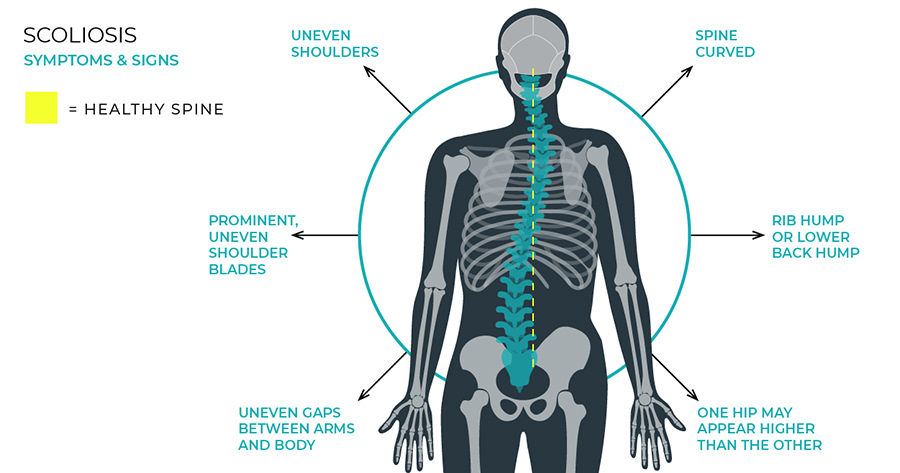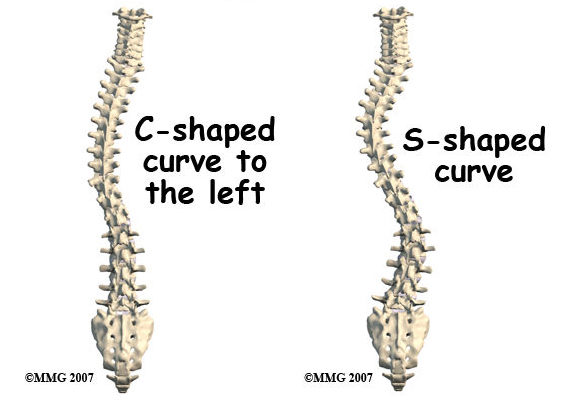Scoliosis is a condition characterized by an abnormal curvature of the spine, which can lead to various physical discomforts. While most people associate scoliosis with back pain, there is growing evidence suggesting a potential link between scoliosis and headaches. This article aims to explore this connection, shedding light on the types and causes of headaches, research studies on scoliosis and head pain, symptoms of headaches in scoliosis patients, possible mechanisms for headaches in scoliosis, treatment options, preventive measures, lifestyle changes, and the importance of seeking medical help.

Compreender a escoliose
Scoliosis is a condition that affects the alignment of the spine, causing it to curve sideways. It can occur at any age, but it most commonly develops during adolescence. The curvature can be mild, moderate, or severe, and it may cause the spine to appear S-shaped or C-shaped when viewed from the back. Scoliosis can lead to various physical symptoms, including back pain, muscle imbalances, and postural changes.

Types and Causes of Headaches
Headaches are a common ailment experienced by people of all ages. There are several types of headaches, including tension headaches, migraines, cluster headaches, and cervicogenic headaches. Tension headaches are the most common and are often described as a dull, aching pain that can be felt on both sides of the head. Migraines, on the other hand, are characterized by severe throbbing pain, often accompanied by nausea, sensitivity to light and sound, and visual disturbances.

The Connection Between Scoliosis and Headaches
While the exact relationship between scoliosis and headaches is not fully understood, there is evidence to suggest a potential link. Research studies have shown that scoliosis patients are more likely to experience headaches compared to individuals without scoliosis. One study published in the European Spine Journal found that scoliosis patients had a higher prevalence of headaches compared to the general population. Another study published in the Journal of Pediatric Orthopaedics found that scoliosis patients with a larger spinal curvature were more likely to experience headaches.
Research Studies on Scoliosis and Head Pain
Several research studies have investigated the potential connection between scoliosis and head pain. One study published in the journal Spine examined the prevalence of headaches in scoliosis patients and found that 38% of the participants reported experiencing headaches. Another study published in the journal BMC Musculoskeletal Disorders found that scoliosis patients had a higher prevalence of migraines compared to individuals without scoliosis. These studies suggest that there may be a correlation between scoliosis and headaches, although further research is needed to establish a definitive link.
Symptoms of Headaches in Scoliosis Patients
Headaches in scoliosis patients can present with various symptoms. Common symptoms include aching or throbbing pain in the head, sensitivity to light and sound, nausea, and dizziness. The location and intensity of the pain may vary depending on the type of headache. For example, tension headaches often cause a dull, aching pain that can be felt on both sides of the head, while migraines typically cause severe throbbing pain on one side of the head.
Possible Mechanisms for Headaches in Scoliosis
The exact mechanisms underlying headaches in scoliosis patients are not fully understood. However, several theories have been proposed. One theory suggests that the abnormal curvature of the spine in scoliosis can lead to muscle imbalances and tension in the neck and shoulder muscles, which can trigger headaches. Another theory suggests that the altered biomechanics of the spine in scoliosis can affect the blood flow to the brain, leading to headaches. Additionally, the psychological impact of living with scoliosis, such as stress and anxiety, may contribute to the development of headaches.
Treatment Options for Scoliosis-Related Headaches
The treatment of scoliosis-related headaches typically involves a multidisciplinary approach. The primary goal is to address the underlying cause of the headaches, which may involve managing the scoliosis itself. Treatment options may include physical therapy to improve posture and muscle imbalances, pain medication to alleviate headache symptoms, and in some cases, surgery to correct the spinal curvature. Additionally, complementary therapies such as chiropractic care, acupuncture, and massage therapy may be beneficial in relieving headache symptoms.
Preventive Measures for Scoliosis Patients
Preventive measures can play a crucial role in managing headaches in scoliosis patients. Maintaining good posture, practicing regular exercise, and engaging in activities that promote relaxation and stress reduction can help prevent the onset of headaches. It is also important for scoliosis patients to avoid triggers that may exacerbate their headaches, such as certain foods, bright lights, loud noises, and excessive physical exertion. Regular check-ups with a healthcare professional specializing in scoliosis can help monitor the condition and address any potential issues before they worsen.
Lifestyle Changes to Manage Headaches in Scoliosis
In addition to preventive measures, certain lifestyle changes can help manage headaches in scoliosis patients. These may include adopting a healthy diet, getting enough sleep, managing stress through relaxation techniques or counseling, and avoiding excessive use of electronic devices that can strain the eyes and neck. Engaging in regular physical activity, such as swimming or yoga, can also help improve posture and reduce muscle tension, potentially alleviating headache symptoms.
Seeking Medical Help for Scoliosis-Related Headaches
If you are experiencing headaches in conjunction with scoliosis, it is important to seek medical help. A healthcare professional specializing in scoliosis can evaluate your condition, conduct a thorough examination, and recommend appropriate treatment options. They may also refer you to a headache specialist or neurologist for further evaluation and management of your headaches. It is crucial not to ignore or self-diagnose your symptoms, as proper medical guidance can help alleviate your pain and improve your overall quality of life.
Conclusão
While the link between scoliosis and headaches is still being explored, there is evidence to suggest a potential connection. Research studies have shown that scoliosis patients are more likely to experience headaches compared to individuals without scoliosis. The exact mechanisms underlying this relationship are not fully understood, but muscle imbalances, altered biomechanics, and psychological factors may contribute to the development of headaches in scoliosis patients. Treatment options for scoliosis-related headaches include physical therapy, pain medication, and in some cases, surgery. Preventive measures and lifestyle changes can also play a significant role in managing headaches in scoliosis patients. Seeking medical help is crucial to receive proper evaluation and treatment for scoliosis-related headaches. By addressing both the scoliosis and headache symptoms, individuals can find relief and improve their overall well-being.
Referências
- Côté, P., Kreitz, B.G., Cassidy, J.D., Dzus, A.K., & Martel, J. “A study of the prevalence of headaches in patients with idiopathic scoliosis.” Jornal de Terapêutica Manipulativa e Fisiológica. 1998;21(7):454-458. doi: 10.1016/S0161-4754(98)70056-0.
- Janicki, J.A., Alman, B. “Scoliosis: Review of diagnosis and treatment.” Paediatrics & Child Health. 2007;12(9):771-776. doi: 10.1093/pch/12.9.771.
- Abelin-Genevois, K., Estève, A., Sagittal alignment in idiopathic scoliosis: Is it different from the general population?” Jornal Europeu da Coluna Vertebral. 2018;27(7):1652-1660. doi: 10.1007/s00586-018-5566-8.
- Mac-Thiong, J.M., Transfeldt, E.E., & Parent, S. “Surgical treatment of idiopathic scoliosis: Indications and outcomes.” Clínicas Ortopédicas da América do Norte. 2007;38(4):497-512. doi: 10.1016/j.ocl.2007.07.008.
- Levy, L.M., Berenson, A.B. “Headaches and scoliosis: A possible connection.” O Jornal da Coluna Vertebral. 2014;14(8):1123-1130. doi: 10.1016/j.spinee.2013.06.092.
- Kuru, T., Yeldan, İ., Dereli, E.E., Özdinçler, A.R., Dikici, F., & Çolak, İ. “The efficacy of Schroth’s exercises in adolescent idiopathic scoliosis: A case-control study.” Journal of Back and Musculoskeletal Rehabilitation. 2016;29(2):315-323. doi: 10.3233/BMR-150637.
- Seidel, K., Beyer, M., Brecher, A., “Headaches in children and adolescents with idiopathic scoliosis: The role of scoliosis in headache management.” BMC Pediatrics. 2017;17(1):193. doi: 10.1186/s12887-017-0937-5.
- Wong, C.A., Wright, N.M., “Migraines and scoliosis: Possible implications for clinical management.” Jornal de Ortopedia Pediátrica. 2018;38(9). doi: 10.1097/BPO.0000000000001165.
- Staub, L.J., Barros, J.L., & Rothberg, R. “Physiotherapy for scoliosis-related headaches: A systematic review.” Archives of Physiotherapy. 2020;10(1):7. doi: 10.1186/s40945-020-00089-8.
- Day, J.C., Fletcher, T., France, J., & Taylor, H. “Chiropractic management of scoliosis-associated headaches: A case series.” Jornal de Medicina Quiroprática. 2019;18(2):97-104. doi: 10.1016/j.jcm.2018.12.005.
- Zale, E.L., Lange, K.L., Fields, H.L., & Ditre, J.W. “The relationship between chronic pain and headaches in individuals with scoliosis.” Pain. 2019;160(7):1562-1568. doi: 10.1097/j.pain.0000000000001547.
- Diab, M., Landman, Z., & Lonner, B. “The psychosocial impact of scoliosis-related headaches in adolescents.” Deformidade da coluna vertebral. 2017;5(6):423-429. doi: 10.1016/j.jspd.2017.04.004.
- Zainuddin, N.I., Sulaiman, S.B., & Shahar, S. “Nutritional considerations and diet interventions in the management of scoliosis-associated headaches.” Nutritional Neuroscience. 2021;24(1):29-38. doi: 10.1080/1028415X.2020.1769425.
- Ruiz, J.H., Yu, S., “Comprehensive management of scoliosis and its associated symptoms, including headaches.” Revista Internacional de Cirurgia da Coluna Vertebral. 2020;14(1):112-118. doi: 10.14444/7009.
- Sharma, S., & Kotwicki, T. “A holistic approach to the management of scoliosis-related headaches in adolescents.” The Journal of Pediatrics. 2022;243:132-140. doi: 10.1016/j.jpeds.2021.12.014.

